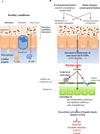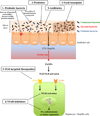Microbiota-liver axis in hepatic disease
- PMID: 23703735
- PMCID: PMC4084781
- DOI: 10.1002/hep.26494
Microbiota-liver axis in hepatic disease
Abstract
Accumulating evidence indicates that the gut microbiota, long appreciated to be a key determinant of intestinal inflammation, is also playing a key role in chronic inflammatory disease of the liver. Such studies have yielded a general central hypothesis whereby microbiota products activate the innate immune system to drive proinflammatory gene expression, thus promoting chronic inflammatory disease of the liver. This article reviews the background supporting this hypothesis, outlines how it can potentially explain classic and newly emerging epidemiological chronic inflammatory liver disease, and discusses potential therapeutic means to manipulate the microbiota so as to prevent and/or treat liver disease.
© 2013 by the American Association for the Study of Liver Diseases.
Figures


References
-
- Hooper LV, Macpherson AJ. Immune adaptations that maintain homeostasis with the intestinal microbiota. Nat Rev Immunol. 2010;10:159–169. - PubMed
-
- Mariathasan S, Monack DM. Inflammasome adaptors and sensors: intracellular regulators of infection and inflammation. Nature reviews. Immunology. 2007;7:31–40. - PubMed
-
- Trinchieri G, Sher A. Cooperation of Toll-like receptor signals in innate immune defence. Nature reviews. Immunology. 2007;7:179–190. - PubMed
-
- Carvalho FA, Aitken JD, Vijay-Kumar M, Gewirtz AT. Toll-like receptor-gut microbiota interactions: perturb at your own risk! Annual review of physiology. 2012;74:177–198. - PubMed
Publication types
MeSH terms
Grants and funding
LinkOut - more resources
Full Text Sources
Other Literature Sources
Medical
